In 2024, having a deep understanding of how to build a SaaS database design is more crucial than ever. SaaS, or Software as a Service, is a model where software is provided over the internet, eliminating users needing to download, install, and maintain it on their devices.
This not only enhances accessibility but also mitigates the adverse impact of manual installations and maintenance, making the SaaS approach increasingly imperative in avoiding disruptions and ensuring seamless user experiences.
At Aloa, we focus on providing businesses with cost-effective software development services and comprehensive guides on navigating the intricate landscape of SaaS database design. Through our expertise, we aim to empower businesses with the knowledge to make informed decisions throughout the SaaS development journey.
In this blog, we delve into the intricate development process of crafting a robust SaaS database design, shedding light on its nuanced features and explaining its benefits to businesses. Understanding the intricacies of this process is a strategic move that can elevate your software solution.
Let's dive in!
Development Process for SaaS Database Design
A robust SaaS database design is critical to software development, where careful planning and technical expertise converge. This intricate process involves defining objectives, efficiently modeling data structures, and implementing scalable architectures. Here are the development process and critical strategies to ensure a seamless database design.
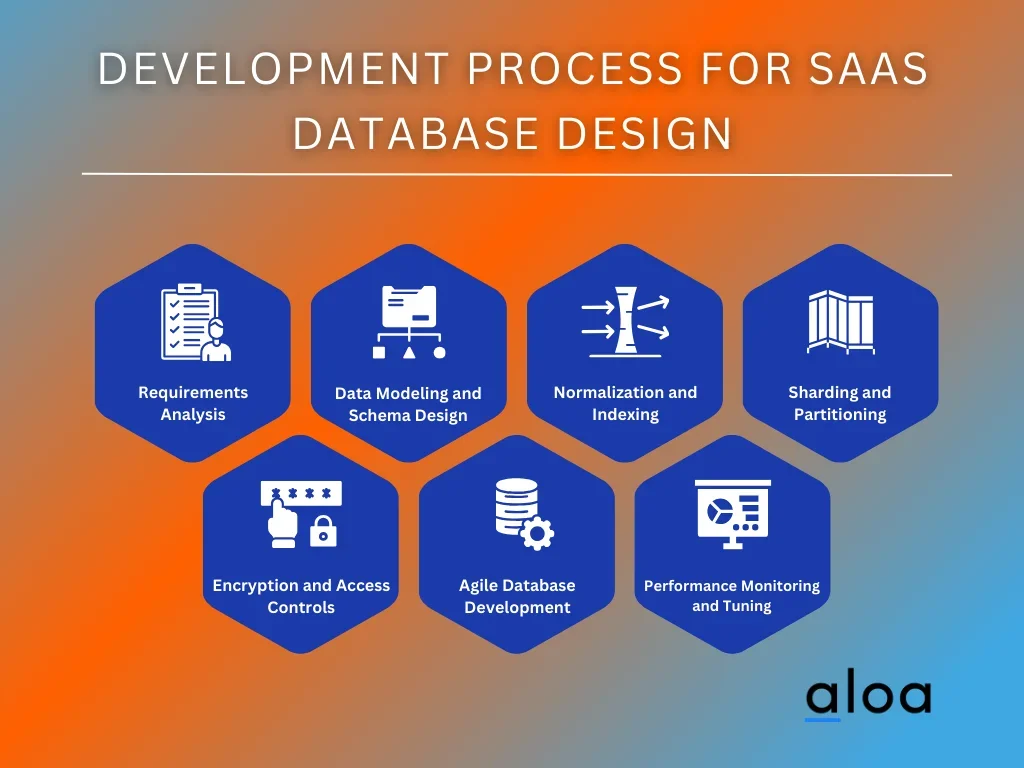
Step 1: Requirements Analysis
In the initial step of SaaS database design, Requirements Analysis plays a pivotal role in shaping the foundation of the database architecture and defining the parameters of the new database model. This process comprehensively examines business and user requirements, focusing on understanding and organizing tenant data on separate databases.
The aim is to create a database that aligns seamlessly with the unique needs of the SaaS application and establishes an efficient and scalable new database model. The development team gains insights into the intricacies of data flow, user interactions, and essential functionalities by conducting thorough analysis sessions and engaging with key stakeholders.
The Requirements Analysis phase establishes a clear understanding of the data entities, relationships, and attributes crucial for the SaaS database through meticulous documentation and feedback loops.
Step 2: Data Modeling and Schema Design
Data Modeling and Schema Design lay the groundwork for a robust data model, ensuring optimal data organization and retrieval within a single database. This phase is critical for shaping a database structure that accommodates the unique requirements of the SaaS application, incorporating schema changes as needed for efficiency and scalability.
Here are the key aspects of data modeling and schema design:
- Entity-Relationship Modeling: Employ advanced techniques to define entities and their relationships, providing a blueprint for the database structure.
- Normalization Strategies: Apply normalization principles to eliminate redundancy and enhance data integrity, creating a more streamlined and efficient database.
- Attribute Definition: Define attributes for each entity, specifying the characteristics of the data to be stored and ensuring comprehensive data representation.
- Indexing for Performance: Implement indexing strategies to optimize query performance, facilitating faster data retrieval and enhancing overall system efficiency.
Carefully considering entities, relationships, attributes, and performance optimization sets the stage for a well-architected and high-performing database.
Step 3: Normalization and Indexing
Normalization and Indexing focus on refining the structure for efficiency and reliability. Normalization is applied to eliminate data redundancy and enhance data integrity, ensuring the SaaS database design remains consistent and accessible from unnecessary duplication.
This process involves systematically organizing data into well-defined tables, reducing anomalies, and streamlining the overall storage structure. Simultaneously, Indexing strategies are implemented to optimize query performance and expedite data retrieval. Indexes act as navigational aids, significantly reducing the time it takes for the database engine to locate and retrieve specific information.
By strategically applying normalization principles and incorporating effective indexing, this step contributes to the overall speed and efficiency of the database and its ability to maintain high data consistency and reliability.
Step 4: Sharding and Partitioning
Sharding and partitioning are essential strategies for architecting a scalable SaaS database design. These techniques involve distributing data across multiple nodes, ensuring the system can handle increased workloads and scale as demands grow.
Here are the key aspects of sharding and partitioning:
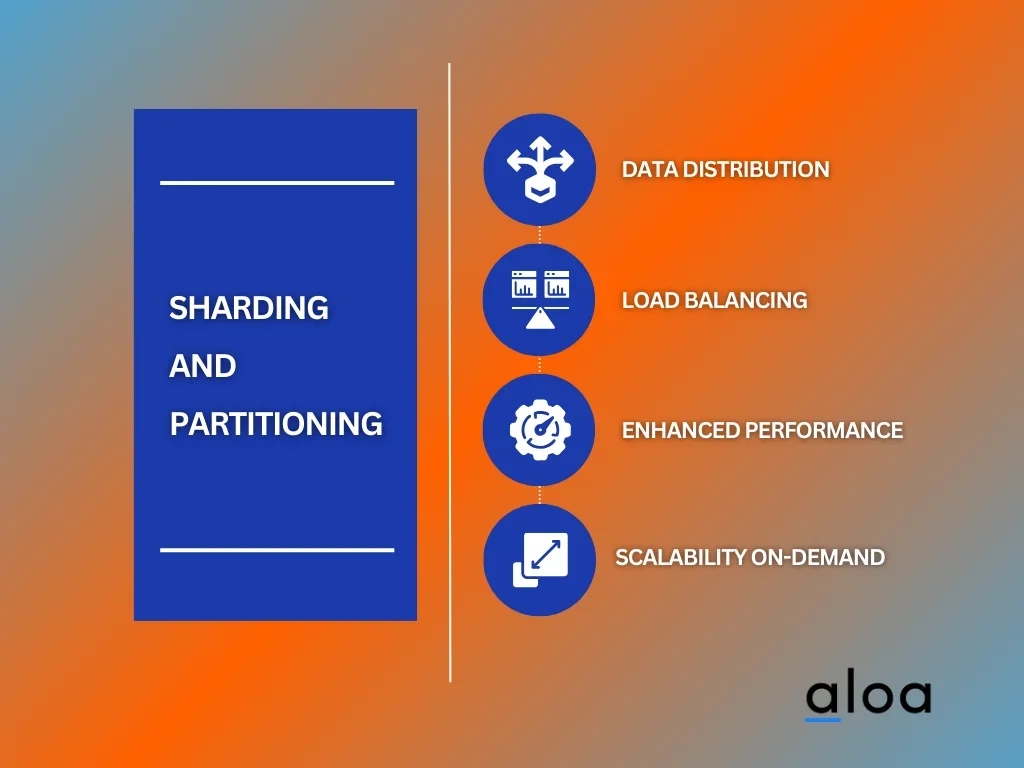
- Data Distribution: Sharding involves horizontally partitioning the database and distributing subsets of data across different servers or nodes to improve parallel processing capabilities.
- Load Balancing: Implementing sharding enables efficient data distribution and facilitates load balancing, ensuring each server bears a fair share of the workload.
- Enhanced Performance: Sharding and partitioning enhance database performance by reducing the load on individual servers, promoting parallel processing, and optimizing resource utilization.
- Scalability On-Demand: By adopting these strategies, the database becomes inherently scalable, expanding seamlessly to accommodate growing data volumes and increasing user demands.
Implementing sharding and partitioning strategies underscores the commitment to scalability, positioning the SaaS database for growth and adaptability in the face of evolving requirements. These techniques lay the groundwork for an architecture that handles current workloads efficiently and allows for seamless scaling in the future.
Step 5: Encryption and Access Controls
Encryption and Access Controls emerge as stalwart guardians of data security in the intricate development process of SaaS database design. Encryption acts as a digital cloak, transforming sensitive information into an unreadable code, ensuring confidentiality, and safeguarding against unauthorized access.
Simultaneously, Access Controls create a digital fortress by regulating entry based on predefined roles and responsibilities, reducing the risk of data breaches. This dynamic duo ensures the integrity of the database. It aligns with stringent data privacy standards, fostering user trust in securely handling their information.
By fortifying the SaaS database with these essential measures, businesses protect sensitive information and demonstrate a dedication to maintaining the highest standards of security, instilling confidence in users, and establishing a solid foundation for a resilient SaaS application.
Step 6: Agile Database Development
Agile database development is about embracing agile methodologies and breaking down database design into iterative cycles. This allows for continuous adaptation to evolving requirements, enhancing flexibility and responsiveness.
Here are the key aspects of Agile Database Development:
- Iterative Design: Agile database development is characterized by iterative cycles that foster continuous refinement, allowing for incorporating changes and improvements in response to evolving project needs.
- Adaptive Flexibility: Agile database development ensures adaptive flexibility, with mechanisms in place to swiftly adjust the database design to changing requirements, providing a dynamic and responsive framework for development.
- Collaborative Approach: Agile database development promotes a collaborative approach, bringing together developers, database administrators, and stakeholders to encourage communication, shared understanding, and quick adjustments based on feedback.
- Continuous Feedback Loops: Agile database development incorporates continuous feedback loops into the process, enabling stakeholders to provide insights that guide ongoing adjustments and improvements.
Embracing an agile approach to database development streamlines the design process. It ensures the database system remains adaptable and responsive to the project's evolving needs. This iterative and collaborative methodology promotes a dynamic development environment, fostering success in the ever-changing landscape of software projects.
Step 7: Performance Monitoring and Tuning
In the dynamic landscape of SaaS database design, the Performance Monitoring and Tuning phase emerges as a crucial checkpoint for ensuring optimal functionality. This process involves continuously assessing and optimizing database performance to guarantee responsive data retrieval and efficient system operation.
By implementing strategic measures such as indexing, query optimization, and caching strategies, developers can fine-tune the database, enhancing both the application performance and its speed, scalability, and overall responsiveness to meet the demands of an evolving user base.
Performance Monitoring and Tuning go beyond just reactive adjustments; they signify a proactive approach to maintaining a high-performing SaaS database. Monitoring key performance indicators allows development teams to identify potential bottlenecks, address issues promptly, and anticipate scaling needs.
Standard Features in SaaS Database Design
SaaS database design encompasses a set of standard features tailored for administrators and end-users, enhancing the overall functionality and accessibility of the software. Here are the standard features in SaaS Database Design for administrators and users:
Features for Admin
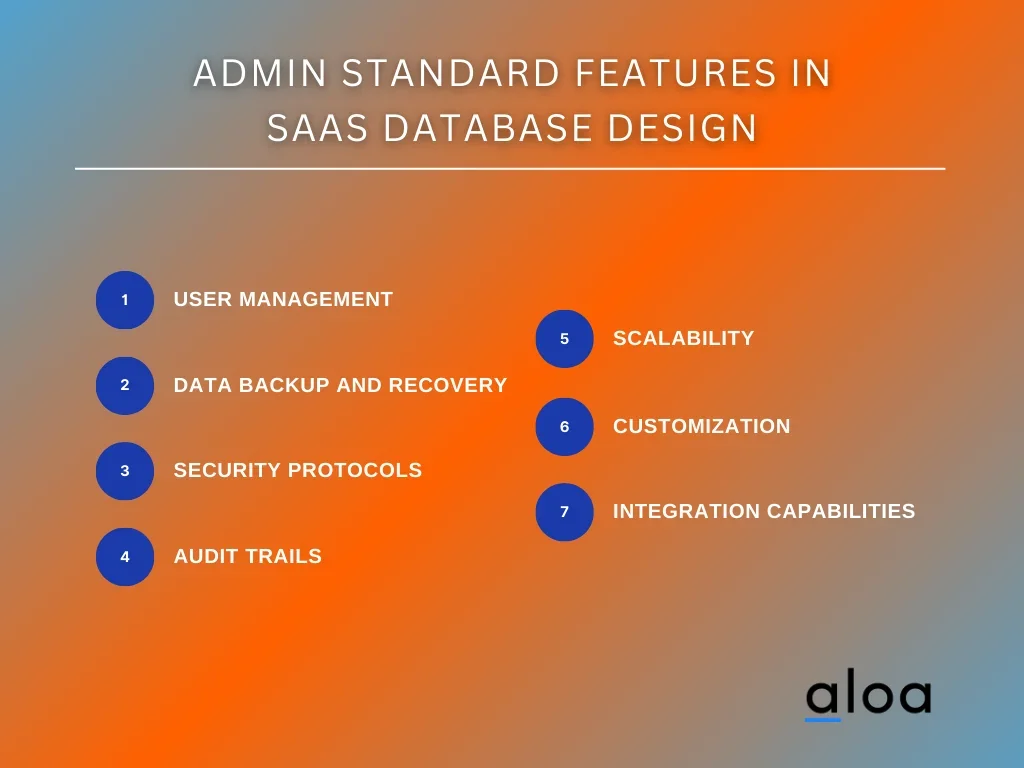
- User Management: Administrators can create, modify, and deactivate user accounts, ensuring controlled access. This functionality is crucial for operational management, allowing tailored control over each tenant's data user access.
- Data Backup and Recovery: Robust backup mechanisms empower administrators to safeguard data integrity by regularly backing up critical information and facilitating efficient recovery processes.
- Security Protocols: Implementing encryption, access controls, and authentication measures ensures that sensitive data within the SaaS database remains protected from unauthorized access.
- Audit Trails: Detailed audit logs allow administrators to track changes, monitor user activities, and investigate security incidents for compliance and troubleshooting purposes.
- Scalability: SaaS database designs commonly offer scalability features, enabling administrators to manage and accommodate growing datasets and user loads effortlessly.
- Customization: Administrative users can configure and customize the database structure, fields, and workflows to align with specific business requirements and evolving needs.
- Integration Capabilities: Seamless integration with other applications and services streamlines workflows, providing administrators with a cohesive ecosystem for managing their operations.
Features for User
Here are the standard features in SaaS Database Design for users:
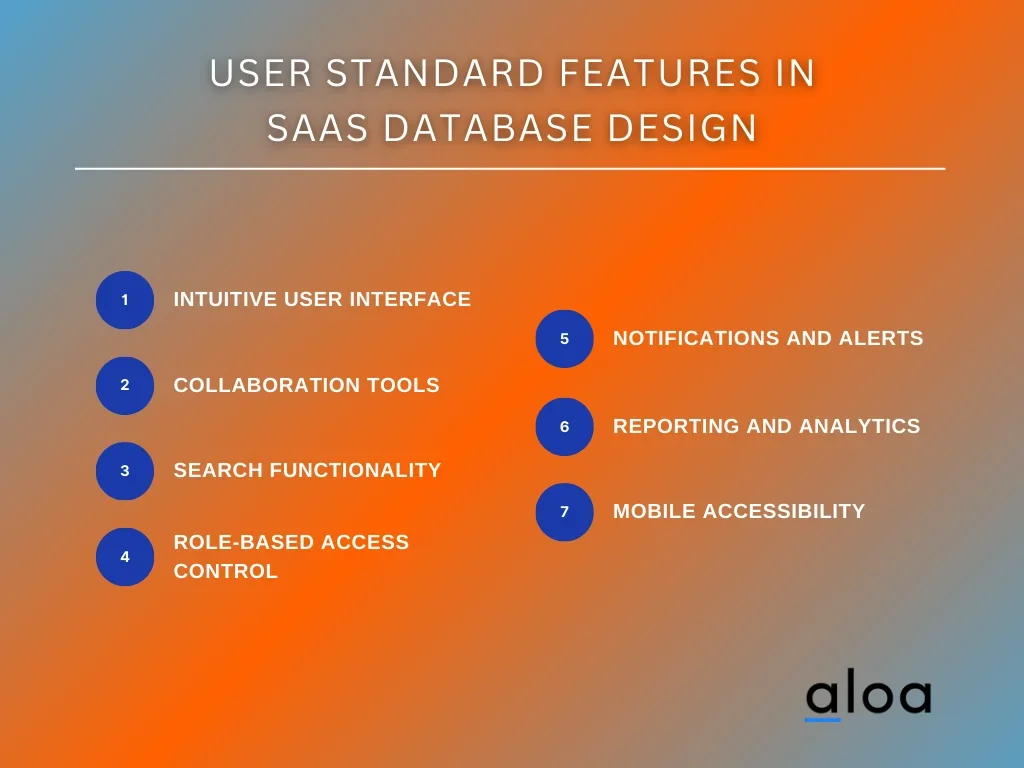
- Intuitive User Interface: A user-friendly interface enhances accessibility, ensuring users can navigate the database efficiently and perform tasks with minimal training.
- Collaboration Tools: Features like real-time collaboration, file sharing, and commenting facilitate effective communication and collaboration among users within the SaaS platform.
- Search Functionality: Users benefit from robust search c apabilities, allowing them to quickly locate and retrieve specific information from the database, improving overall efficiency.
- Role-Based Access Control: Role-based permissions enable users to access only the data and functionalities relevant to their responsibilities, enhancing security and data integrity.
- Notifications and Alerts: Users can set up personalized notifications and alerts to stay informed about critical updates, ensuring timely responses to changes in the database.
- Reporting and Analytics: Access to customizable reports and analytics empowers users to derive meaningful insights from the data stored in the SaaS database, supporting informed decision-making.
- Mobile Accessibility: SaaS database designs often include mobile-friendly interfaces, allowing users to access and manage data on the go, promoting flexibility and productivity.
Benefits of a SaaS Database Design
SaaS database design is a technological cornerstone revolutionizing how organizations manage and leverage their data. Here are the benefits of a SaaS Database Design:
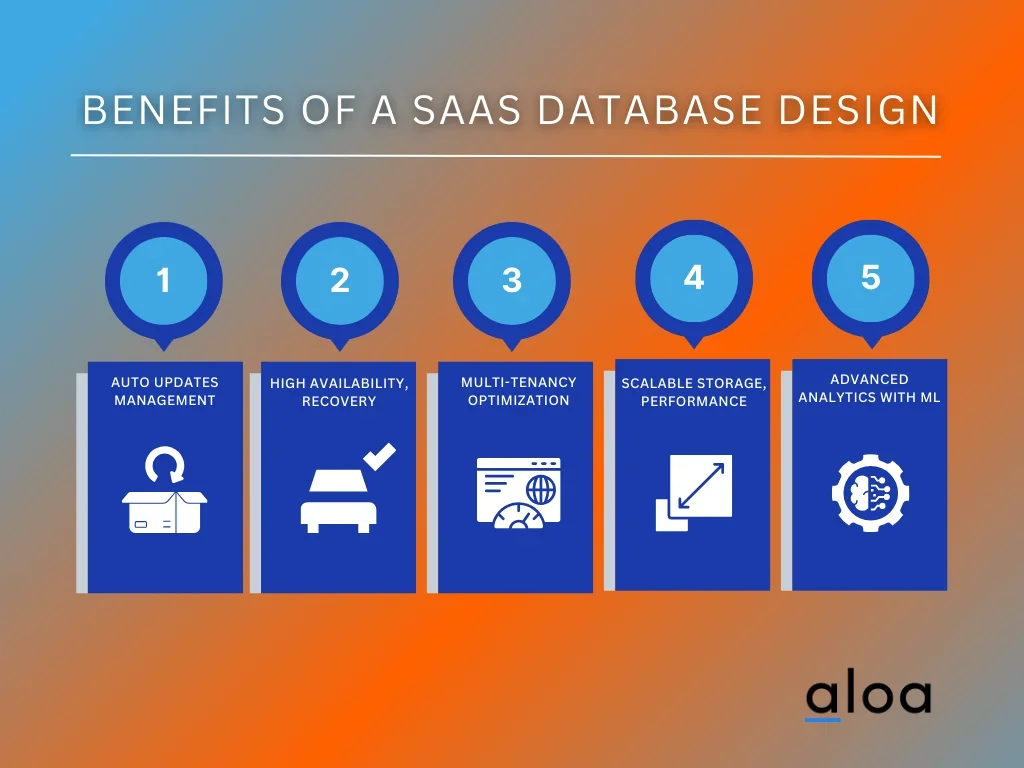
1. Automatic Updates and Patch Management
SaaS database designs excel in automating updates, ensuring a seamless upgrade process, and patch management. This relieves organizations, including administrators and subscribers, from the intricate process of manually implementing and validating changes. A patch management tool is often incorporated to efficiently track, test, and deploy updates, further minimizing downtime and ensuring system stability
This streamlined approach ensures the database software is consistently up-to-date with the latest features, bug fixes, and security patches, enhancing overall system efficiency and security.
2. High Availability and Disaster Recovery
SaaS database solutions often incorporate advanced mechanisms for high availability and disaster recovery. With redundant data centers, failover systems, and continuous data backups, these databases ensure minimal downtime during hardware failures or unforeseen disasters, enhancing overall system reliability and usage resilience.
This technical resilience is critical for maintaining continuous operations, preserving data integrity, and meeting stringent service-level agreements (SLAs) that businesses may have with their users.
3. Multi-Tenancy and Resource Optimization
A key technical benefit of SaaS database design lies in efficiently supporting multi-tenancy. SaaS databases can serve multiple clients without compromising performance through resource pooling and shared infrastructure.
This results in optimal resource utilization, as the underlying infrastructure dynamically allocates computing resources based on demand. The ability to efficiently share resources across different users enhances scalability and cost-effectiveness.
4. Scalable Storage and Performance
SaaS databases leverage scalable storage architectures, such as distributed file systems and cloud storage services, to accommodate growing volumes of data. Additionally, these databases often implement sharding, partitioning, or other techniques to distribute data across multiple nodes for enhanced performance.
As the database scales horizontally, it can handle increased workloads and ensure consistent responsiveness, even as the volume of data and user activity grows.
5. Advanced Analytics and Machine Learning Integration
Many SaaS database designs incorporate advanced analytics, machine learning capabilities, and metrics, providing users with the tools to derive meaningful insights from their data. This technical aspect allows organizations to analyze large datasets efficiently, uncover patterns, and make data-driven decisions.
The seamless integration of machine learning models into the database infrastructure enables predictive analytics, anomaly detection, and other advanced functionalities and streamlines management operations for a more intelligent and responsive data environment.
Key Takeaway
SaaS database design plays a pivotal role in shaping the core infrastructure of the corresponding database. Understanding its development process establishes a foundation for continuous improvement and responsiveness to evolving technological landscapes.
This knowledge empowers businesses to adapt and optimize their own database, fostering a more tailored and efficient software infrastructure that precisely meets their evolving needs.
Aloa provides invaluable insights and practical tips into the development process of various software solutions. The commitment is not just to offer development services but to be a trusted partner in navigating the dynamic landscape of software architecture.
To learn more about Aloa and how we can elevate your software development journey, explore our wealth of resources and insights. Whether seeking expert guidance on development processes or aiming to enhance your overall software strategy, Aloa is here to be your trusted partner. Explore the possibilities with Aloa – where your software goals meet expert guidance.

